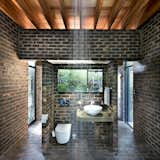The bedroom/living space is enclosed by large glass windows framing the treescape. “I think one of the most successful experiential aspects of a building is how intimately involved it is with the site,” says architect Ant Vervoort. “An expensive view has the effect of divorcing one from the site. In House of the Tall Chimneys, the views are very close and intimate, which makes you part of the site.” The timber used throughout is Eucalyptus saligna, which is native to Australia and sustainably grown and harvested in South Africa.
The team lidar scanned around 40,000 square meters of the forested site to create a 3D model—including trees, branches, and roots—that would allow them to accurately determine how to position and design the building to have minimal impact on the surrounding trees. “We then designed a seriously thin building that could slot between the trees,” says architect Ant Vervoort.




